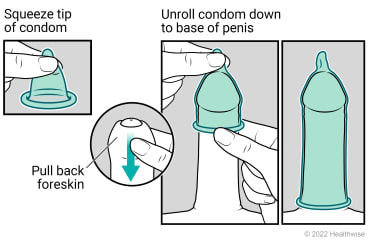What are condoms?

Condoms can be used to prevent pregnancy. They also help protect against sexually transmitted infections (STIs). Condoms are called a barrier method of birth control. That's because they keep the sperm and eggs apart. The condom holds the sperm so the sperm can't get into the vagina.
You must use a new condom each time you have vaginal sex.
External (male) condoms are usually made of latex (rubber) or soft plastic. Sometimes they are made of natural membrane (lambskin). External condoms are placed over a hard (erect) penis before sex. External condoms are also called "rubbers," "sheaths," or "skins."
There are many different kinds of external condoms. Some condoms are lubricated. Some are ribbed. Most have a tip for holding the semen. You can also buy condoms of different sizes.
Internal (female) condoms are tubes of soft plastic or rubber with a closed end. Each end has a ring or rim. The ring at the closed end is put deep into the vagina over the cervix. This holds the tube in place. The ring at the open end stays outside the opening of the vagina. Internal condoms have lubricant on the inside.
How well do they work?
How well condoms work for preventing pregnancy depends on the type of condom you use.
- When external (male) condoms are used exactly as directed, they are about 98% effective for preventing pregnancy. This means that 2 out of 100 people who use them will have an unplanned pregnancy. When they are not used exactly as directed, they are about 87% effective for preventing pregnancy. This means that 13 out of 100 people who use them will have an unplanned pregnancy.
- When internal (female) condoms are used exactly as directed, they are about 95% effective for preventing pregnancy. This means that 5 out of 100 people who use them will have an unplanned pregnancy. When they are not used exactly as directed, they are about 79% effective for preventing pregnancy. This means that 21 out of 100 people who use them will have an unplanned pregnancy.
What should you think about when using condoms?
Some pros of using condoms
- Condoms may be available for free at family planning clinics. You can buy external (male) condoms without a prescription at clinics, in drugstores, online, and in some grocery stores.
- Internal (female) condoms and rubber and plastic external condoms help protect against sexually transmitted infections (STIs), such as herpes or HIV. Sheep intestine condoms don't protect against STIs.
- Condoms don't use hormones. So you can use condoms if you don't want to take hormones or can't take hormones because you have certain health problems or concerns.
- Condoms are safe to use while breastfeeding.
- They cost less than hormonal types of birth control.
- Internal condoms can be inserted up to 8 hours ahead of time. You don't have to interrupt sex.
Some cons of using condoms
- Condoms don't prevent pregnancy as well as IUDs or other hormonal forms of birth control.
- Condoms prevent pregnancy only if you use them every time you have vaginal sex.
- Condoms may break or leak.
- You may have to interrupt sex to put on or insert the condom.
- You must remove the condom right after sex.
- You may have less sexual sensation when using a condom
If you think you used a condom incorrectly, you can use emergency contraception to help prevent pregnancy. The most effective emergency contraception is an IUD (inserted by a doctor). You can also get emergency contraceptive pills. You can get them with a prescription from your doctor or without a prescription at most drugstores.
Where can you learn more?
Go to http://www.healthwise.net/patientEd
Enter G366 in the search box to learn more about "Learning About Birth Control: Condoms".
Current as of: May 5, 2025
Author: Ignite Healthwise, LLC Staff
Clinical Review Board
All Ignite Healthwise, LLC education is reviewed by a team that includes physicians, nurses, advanced practitioners, registered dieticians, and other healthcare professionals.

